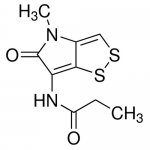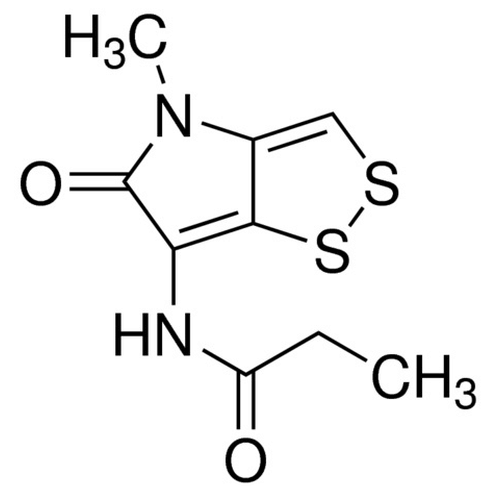| Product Name | Thiolutin |
| Description |
RNA polymerase inhibitor |
| Purity | >98% (TLC); NMR (Conforms) |
| CAS No. | 87-11-6 |
| Molecular Formula | C8H8N2O2S2 |
| Molecular Weight | 228.3 |
| Field of Use | Not for use in humans. Not for use in diagnostics or therapeutics. For in vitro research use only. |
Properties
| Storage Temperature | -20ºC |
| Shipping Temperature | Shipped Ambient |
| Product Type | Inhibitor |
| Solubility | May be dissolved in DMSO (15 mg/ml) |
| Source | Synthetic |
| Appearance | Yellow powder |
| SMILES | CC(=O)NC1=C2C(=CSS2)N(C1=O)C |
| InChI | InChI=1S/C8H8N2O2S2/c1-4(11)9-6-7-5(3-13-14-7)10(2)8(6)12/h3H,1-2H3,(H,9,11) |
| InChIKey | MHMRAFONCSQAIA-UHFFFAOYSA-N |
| Safety Phrases |
Classification: Danger. Safety Phrases: S22 - Do not breathe dust S24/25 - Avoid contact with skin and eyes S36/37/39 - Wear suitable protective clothing, gloves and eye/face protection Hazard Phrases: H300 – Fatal if swallowed H330 – Fatal if inhaled Precautionary Phrases: P260 – Do not breathe dust/fume/gas/mist/vapours/spray P301+P310 IF SWALLOWED: Immediately call a POISON CENTER or doctor/physician P405 – Store locked up |
| Cite This Product | Thiolutin (StressMarq Biosciences Inc., Victoria BC CANADA, Catalog # SIH-375) |
Biological Description
| Alternative Names | N-(4,5-Dihydro-4-methyl-5-oxo-1,2-d¬ithiolo[4,3-b]pyrrol-6-yl)acetamide |
| Research Areas | Cell Signaling |
| PubChem ID | 6870 |
| Scientific Background | Thiolutin is a sulfur antibiotic. Studies show the potential transcriptional inhibition on yeast degradation. By calculating the mRNA decay rates of transcription at different times after inhibition, it was evident that the effect of Thiolutin on the various degradation pathways of mRNA compromises the stability of the mRNA and the mechanism of gene expression (1). In pharmacology is known to inhibit endothelial cell adhesion by perturbing Hsp 27 interactions with components of the actin and intermediate filament cytoskeleton (2). Studies shown the inhibition of tumor cell-induced angionegesis in vivo, adhesion of endothelial cells to vitronectin ( IC50=0.83 µM) (3). Potentially inhibits developmental angiogenesis in zebrafish (2). Cell permeable. Active in vivo. Looking for more information on HSP27? Visit our new HSP27 Scientific Resource Guide at http://www.HSP27.com. |
| References |
1. Pelechano V. and Perez-Ortin J. (2008) Yeast 25: 85-92. 2. Jia Y., et al. (2010) Cell Stress Chaperones 15: 165. 3. Minamiguchi K., et al. (2001) International J. Cancer. 93: 307. |



Reviews
There are no reviews yet.